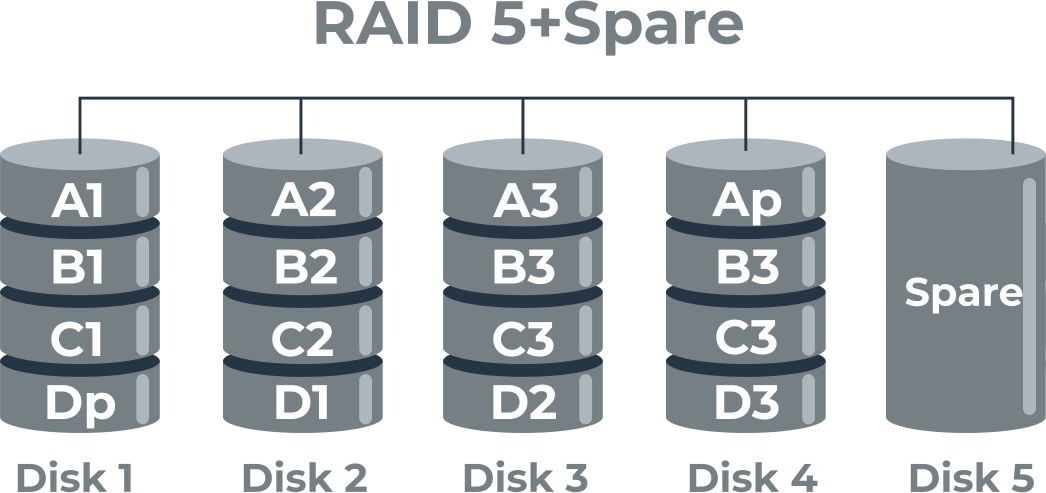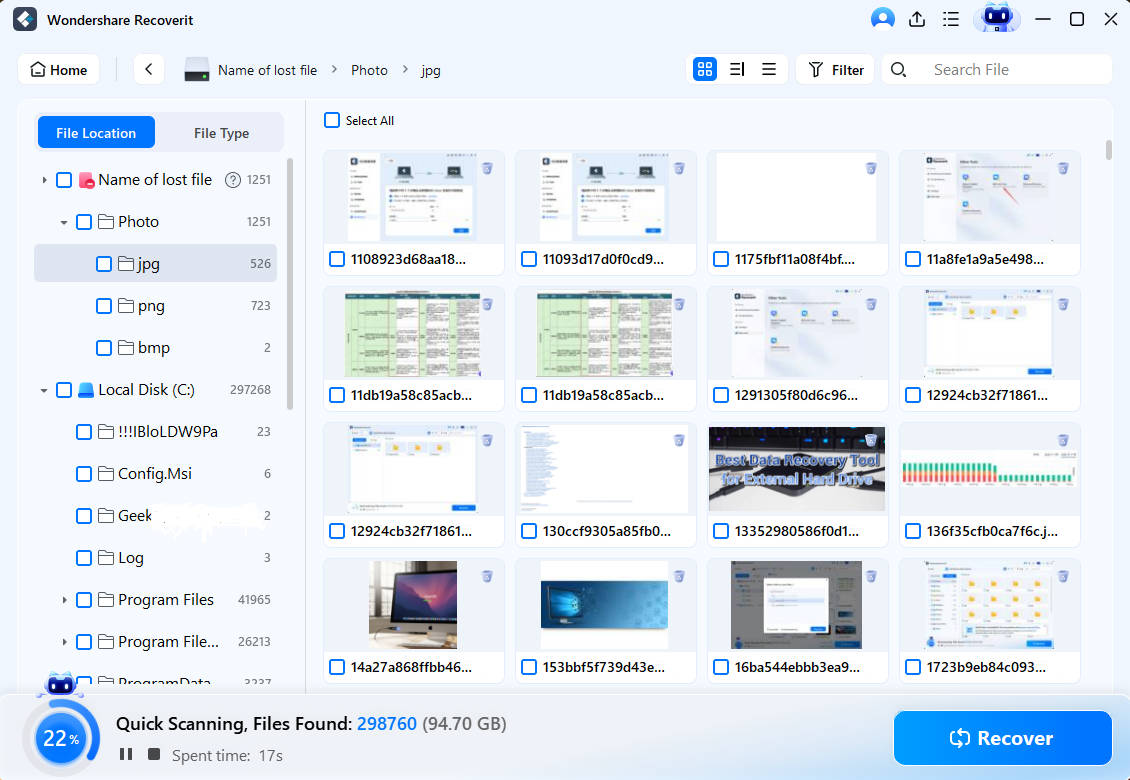Ever asked yourself: What is RAID5E? RAID5E is a cool topic in data storage. Knowing the differences between RAID 5E vs RAID 5 and RAID 5E vs RAID 5EE can help you choose the best system. We will also look at how to recover lost data from RAID5E on Windows and how to recover lost data from RAID5E on Mac.
RAID5E (Redundant Array of Independent Disks) comes with Enhanced capabilities. It’s like a superhero for data, giving better performance and protection. If you handle lots of data, knowing what is RAID5E and how it differs from RAID 5 and RAID 5EE is important.
This guide will cover everything about RAID5E. From basics to comparisons, and tips on recovering RAID data on Windows and Mac. Let’s explore the world of RAID5E together!
In this article
Part 1: What is RAID5E?

RAID5E, or Redundant Array of Independent Disks Enhanced, is a RAID level that enhances RAID 5 by adding a hot spare. This means that if one disk fails, the hot spare takes over immediately, reducing downtime and maintaining data protection. RAID5E delivers superior performance and enhanced reliability compared to RAID 5.
In simple terms, RAID5E is all about enhancing data storage efficiency and protection. It is designed to recover from disk failures quickly and maintain the integrity of the data stored. Knowing what is RAID5E can help you understand its advantages and why it might be the right choice for your storage needs.
Part 2: RAID 5E vs RAID 5: What is the Difference?
When comparing RAID 5E vs RAID 5, it's essential to understand the key differences to make an informed decision. RAID 5E, an enhancement of RAID 5, includes a hot spare disk that automatically takes over in case of a disk failure, providing faster recovery and reduced downtime. This significant difference makes RAID 5E more efficient and reliable, especially for critical data storage needs. Here's a detailed comparison to help you understand the distinctions between these RAID levels.
| Feature | RAID 5 | RAID 5E |
| Hot Spare | No | Yes |
| Downtime on Disk Failure | Higher downtime due to manual intervention required for recovery | Lower downtime as hot spare takes over immediately |
| Data Recovery Speed | Slower recovery as it requires rebuilding data manually | Faster recovery with automatic use of hot spare |
| Performance | Good performance in normal operation | Enhanced performance due to reduced downtime and faster recovery |
| Storage Efficiency | Effective but relies on parity data | Efficient with added hot spare for reliability |
| Usability | Suitable for general data storage needs | Ideal for critical data that requires high availability and quick recovery |
This table provides a clearer and more detailed comparison between RAID 5 and RAID 5E, helping you see the key advantages of RAID 5E in terms of recovery time, performance, and reliability.
Part 3: RAID 5E vs RAID 5EE: Which is Better?

When deciding between RAID 5E vs RAID 5EE, understanding their differences is crucial for choosing the right RAID level for your data storage needs. Both RAID 5E and RAID 5EE offer enhanced performance and reliability, but they achieve it in different ways. RAID 5E includes a single hot spare disk, while RAID 5EE includes multiple hot spares, allowing for even faster recovery and better performance.
Let's explore the details to see which one suits your requirements better.
Hot Spare Inclusion:
RAID 5E: Includes a hot spare
RAID 5EE: Includes multiple hot spares
Performance:
RAID 5E: Enhanced performance with a single hot spare
RAID 5EE: Better performance with multiple hot spares
Recovery Time:
RAID 5E: Faster recovery with one spare
RAID 5EE: Even faster recovery with multiple spares
Part 4: How To Recover Lost Data From RAID5E on Windows and Mac
Experiencing data loss from a RAID5E array can be stressful, but recovery is possible with the right steps and tools. Whether you're using Windows or Mac, there are methods to recover your valuable data efficiently. In this section, we'll walk you through the crucial steps of minimizing RAID usage and using the Recoverit tool to recover lost data from RAID5E.
By following these steps, you can regain access to your important files and maintain the integrity of your RAID5E array.
Step 1: Minimize the RAID Usage

To recover lost data from RAID5E, the first and most crucial step is to minimize the usage of the RAID array immediately after noticing data loss. Using the RAID array can lead to further data overwriting or corruption. This makes recovery more difficult. Stopping all read/write operations helps preserve the integrity of the remaining data.
This precaution helps prevent additional stress or failure within the RAID system. Thus, ensuring that recovery tools can work more effectively when attempting to retrieve your lost data.
Step 2: Use the Recoverit Tool
To recover lost data from RAID5E, using a reliable data recovery tool is essential. One such tool is Recoverit, known for its effectiveness and user-friendly interface. Recoverit can handle data recovery from various storage devices, including RAID arrays, making it an ideal choice for RAID5E. By utilizing specialized algorithms, Recoverit can scan your RAID array, identify lost or corrupted data, and facilitate its recovery.
Before you begin, ensure you have minimized the usage of your RAID array to prevent further data loss. Once ready, download and install the Recoverit tool on your Windows or Mac system. Follow the on-screen instructions to perform a deep scan of your RAID5E array. Recoverit will display a list of recoverable files, allowing you to select and restore the ones you need. This straightforward process makes Recoverit a powerful ally in data recovery, ensuring your valuable information can be retrieved efficiently and securely.
Simple Steps to Use Recoverit Tool
- Get the Recoverit tool and install it on your computer. Open Recoverit, select the RAID5E array.

- Start the scanning process.

- Once the scan is complete, review the list of recoverable files, select the ones you need, and restore them.

By following these simple steps, you can effectively recover lost data from RAID5E using the Recoverit tool.
Part 5: Tips for Efficient RAID5E Recovery

Efficient recovery of data from a RAID5E array requires careful planning and proactive measures. Here are some tips to help you recover your data effectively:
- Regular Backups: Always maintain regular backups of your data. This is the most effective way to ensure that you can recover your data even if something goes wrong with your RAID5E array.
- Monitor RAID Health: Keep an eye on the health of your RAID array. Use monitoring tools to check for any signs of potential failures. Early detection of issues can prevent data loss.
- Minimize RAID Usage During Recovery: If you suspect data loss, minimize the usage of your RAID array immediately. This reduces the risk of further data corruption and makes recovery easier.
- Use Professional Data Recovery Tools: Invest in reliable data recovery tools like Recoverit. These tools are specifically designed to handle RAID arrays and can significantly improve your chances of successful data recovery.
- Consult Professionals: If you're unsure about the recovery process or if it's a critical situation, don't hesitate to consult data recovery professionals. Their expertise can be invaluable in ensuring that your data is recovered safely and efficiently.
By following these tips, you can enhance the efficiency of your RAID5E recovery process and safeguard your valuable data.
Related Video >>: What is RAID 1 and How to Set Up?
Comparing RAID 10 to Other RAID Levels
Now that you know what is RAID 10, it is time to compare it with some other RAID configurations. You can check out the links below for the same.
Conclusion
In conclusion, knowing what is RAID5E and understanding its advantages can be extremely beneficial. RAID5E enhances the traditional RAID 5 by adding a hot spare, resulting in better performance and reliability. Comparing RAID 5E vs RAID 5 and RAID 5E vs RAID 5EE can help you choose the best RAID level for your needs.
When faced with data loss, it's crucial to know how to recover lost data from RAID5E on Windows and how to recover lost data from RAID5E on Mac. Using the right tools and techniques can make the recovery process smoother and more efficient.
Always remember, regular backups and monitoring can help prevent data loss and ensure the integrity of your data. By understanding RAID5E and its recovery process, you can better protect your valuable data.
FAQ
-
1. What is RAID5E?
RAID5E stands for Redundant Array of Independent Disks with Enhanced capabilities. It is a RAID level that improves on RAID 5 by adding a hot spare disk. This hot spare automatically takes over if one of the active disks fails, reducing downtime and improving data protection. RAID5E is designed to enhance both performance and reliability, making it a suitable choice for systems requiring high availability and quick recovery from disk failures. -
2. How is RAID5E different from RAID 5?
RAID5E differs from RAID 5 primarily by including a hot spare disk. In a RAID 5 setup, if a disk fails, manual intervention is required to replace the failed disk and rebuild the array, which can lead to significant downtime. In contrast, RAID5E's hot spare disk automatically replaces the failed disk, allowing the array to rebuild itself without manual intervention. This results in faster recovery times, reduced downtime, and improved overall performance compared to RAID 5. -
3. How can I recover lost data from RAID5E on Windows and Mac?
Recovering lost data from RAID5E on Windows and Mac involves a few key steps. First, minimize the usage of the RAID array to prevent further data loss or corruption. Next, download and install a reliable data recovery tool like Recoverit. This tool is compatible with both Windows and Mac systems and is designed to handle RAID arrays. After installation, use the tool to perform a deep scan of your RAID5E array, identify the lost data, and recover the files you need. Following these steps can help you efficiently recover lost data from your RAID5E setup.


 ChatGPT
ChatGPT
 Perplexity
Perplexity
 Google AI Mode
Google AI Mode
 Grok
Grok























